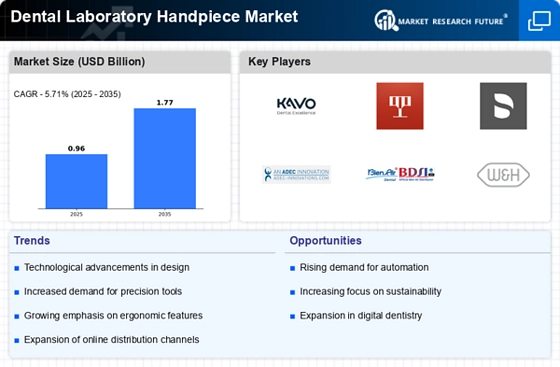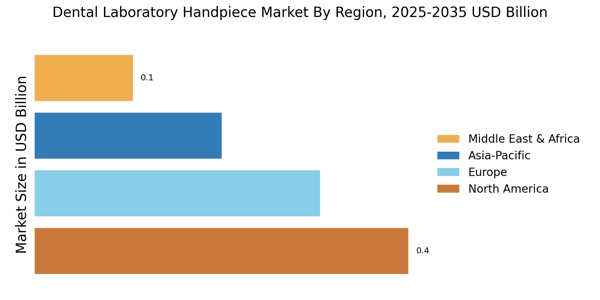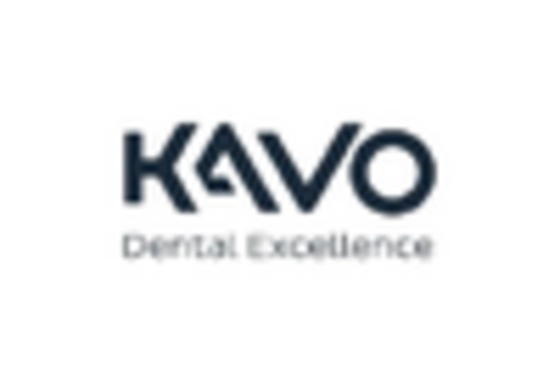Regulatory Standards and Compliance
Regulatory standards and compliance requirements are increasingly influencing the Dental Laboratory Handpiece Market. As dental practices and laboratories strive to meet stringent health and safety regulations, the demand for compliant handpieces is on the rise. Regulatory bodies are continuously updating guidelines to ensure the safety and efficacy of dental equipment, which necessitates that manufacturers adhere to these standards. This compliance not only enhances patient safety but also boosts the credibility of dental laboratories. Market data suggests that handpieces that meet these regulatory requirements are likely to see increased adoption, as dental professionals prioritize equipment that aligns with best practices. Furthermore, the emphasis on quality assurance and risk management in dental laboratories is expected to drive investments in high-quality handpieces that comply with regulatory standards, thereby shaping the market landscape.
Rising Demand for Aesthetic Dentistry
The increasing emphasis on aesthetic dentistry is a notable driver for the Dental Laboratory Handpiece Market. As patients become more conscious of their appearance, the demand for cosmetic dental procedures rises. This trend is reflected in market data, which indicates that the aesthetic dentistry segment is projected to grow at a compound annual growth rate of approximately 8% over the next five years. Consequently, dental laboratories are investing in advanced handpieces that facilitate precise and efficient procedures, thereby enhancing the overall patient experience. The integration of innovative technologies in handpieces, such as LED lighting and improved torque, aligns with the growing expectations of both dental professionals and patients. This shift towards aesthetic enhancements is likely to propel the demand for high-quality dental handpieces, making it a critical factor in the market's expansion.
Growing Awareness of Infection Control
The growing awareness of infection control measures is a critical driver for the Dental Laboratory Handpiece Market. As dental professionals become more vigilant about maintaining hygiene standards, the demand for handpieces that facilitate effective infection control is increasing. Recent surveys indicate that approximately 70% of dental practitioners prioritize infection control features when selecting handpieces. This trend has led manufacturers to innovate and design handpieces with antimicrobial properties and easy-to-clean surfaces. Additionally, the rise in awareness regarding cross-contamination risks has prompted dental laboratories to invest in handpieces that can be sterilized efficiently. The focus on infection control not only enhances patient safety but also aligns with the broader healthcare industry's commitment to quality and safety. As a result, this heightened awareness is likely to drive the demand for specialized handpieces, contributing to the growth of the market.
Increasing Number of Dental Laboratories
The proliferation of dental laboratories is a substantial driver for the Dental Laboratory Handpiece Market. As the number of dental practices continues to rise, so does the demand for laboratory services. Recent statistics indicate that the number of dental laboratories has increased by approximately 5% annually, reflecting a growing need for efficient and reliable handpieces. This trend is further supported by the expansion of dental education programs, which are producing a higher number of qualified dental technicians. Consequently, dental laboratories are seeking advanced handpieces that can enhance productivity and ensure high-quality results. The competitive landscape among laboratories is intensifying, prompting them to invest in state-of-the-art equipment, including handpieces that offer precision and versatility. This increasing establishment of dental laboratories is likely to drive the demand for handpieces, contributing to the overall growth of the market.
Technological Innovations in Handpiece Design
Technological innovations play a pivotal role in shaping the Dental Laboratory Handpiece Market. The introduction of advanced materials and engineering techniques has led to the development of handpieces that are not only more durable but also offer superior performance. For instance, the use of lightweight composites and ergonomic designs enhances usability, reducing fatigue for dental professionals during prolonged procedures. Market analysis suggests that the segment of electric handpieces is experiencing significant growth, with a projected increase in market share due to their efficiency and precision. Furthermore, the integration of smart technologies, such as sensors and connectivity features, is expected to revolutionize the way dental handpieces are utilized in laboratories. These innovations are likely to attract investments and drive competition among manufacturers, ultimately benefiting the Dental Laboratory Handpiece Market.


















Leave a Comment